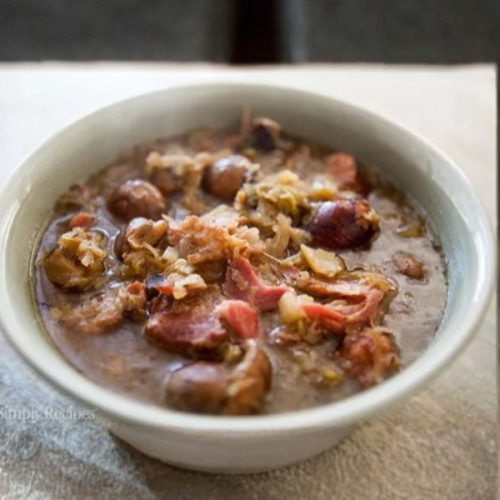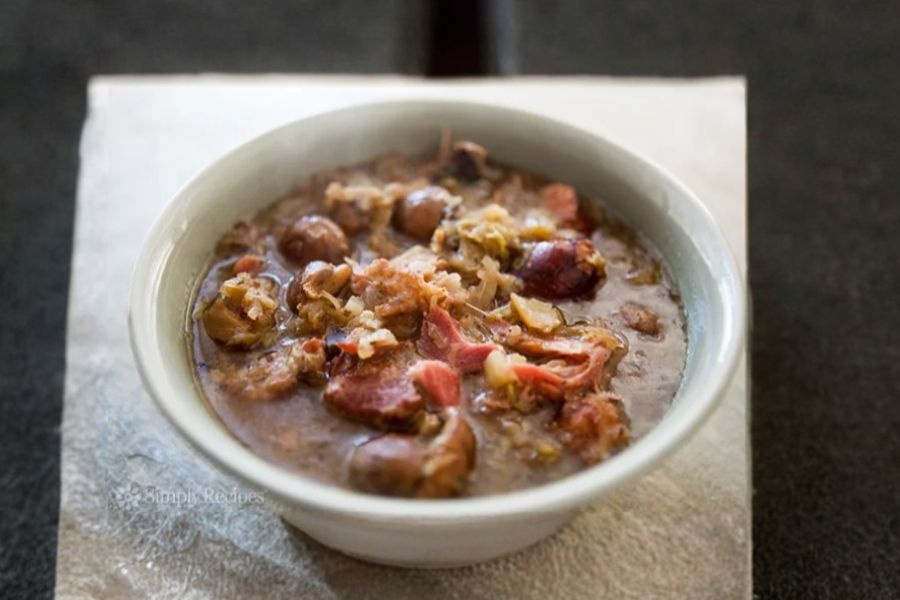Bigos, often called Polish Hunter’s Stew, is a hearty and deeply flavorful dish that combines pork, smoked sausages, cabbage, sauerkraut, and a variety of mushrooms for a satisfying, nutrient-rich meal.
High in protein from pork and sausage, and packed with fiber from cabbage and sauerkraut, this stew is both filling and nutritious.
The addition of dried mushrooms, prunes, and optional tomato paste adds antioxidants and natural sweetness, balancing savory flavors with a touch of richness.
Using beer or stock enhances the depth of flavor while keeping the dish moist without heavy fat.
Bigos is perfect for large gatherings, meal prep, or slow-cooked weekday dinners, as it tastes even better the next day after flavors have melded.

Its combination of protein, fiber, and vegetables makes it a balanced, comforting meal ideal for cold weather or anytime you crave a robust, flavorful stew.
Must-Have Tools for Perfect Results
Large Heavy-Bottomed Pot
Essential for slow-cooking the stew evenly and preventing burning. Its deep design is perfect for large-batch meals like Bigos and other soups or braises.
Chef’s Knife
Used for chopping pork, sausages, cabbage, onions, and mushrooms precisely. A sharp knife ensures even cooking and safe, efficient prep.
Cutting Board
Provides a stable surface for preparing meats and vegetables while protecting countertops. A high-quality board simplifies cleanup and keeps ingredients organized.
Wooden Spoon
Ideal for stirring the stew, scraping browned bits off the bottom of the pot, and mixing ingredients gently without scratching cookware.
Fine Mesh Sieve
Perfect for straining mushroom soaking liquid and other broths. Versatile for rinsing grains, sifting dry ingredients, or making smooth sauces.

Hearty Slow-Cooked Bigos
Equipment
- 1 Large Heavy-Bottomed Pot
- 1 Chef’s Knife
- 1 cutting board
- 1 Wooden spoon
- 1 Fine-Mesh Sieve
Ingredients
Meats
- 2 pounds pork shoulder cut into large chunks
- 1 –2 pounds kielbasa or smoked sausage cut into chunks
- 1 smoked ham hock
- 1 pound fresh Polish sausage optional
Vegetables & Mushrooms
- 1 25-ounce jar fresh sauerkraut, drained
- 1 green cabbage cored and chopped
- 1 large onion chopped
- 1 1/2 pounds fresh mushrooms cleaned and cut
- 1 ounce dried porcini or wild mushrooms soaked and drained
Flavorings & Spices
- 2 tablespoons bacon fat or vegetable oil
- 1 tablespoon juniper berries optional
- 1 tablespoon black peppercorns
- 1 tablespoon caraway seeds
- 2 tablespoons dried marjoram
Salt to taste
- 2 tablespoons tomato paste optional
- 1 12-ounce bottle pilsner or lager beer
- 1 15-ounce can tomato sauce, optional
- 20 prunes halved, optional
- 1 –2 tablespoons mustard or horseradish optional
Instructions
- Soak and Prep Mushrooms: Pour hot water over the dried porcini or other wild mushrooms and let them soak for 20–40 minutes until softened. Drain and reserve the soaking liquid, then clean off any dirt and cut the mushrooms into large pieces, leaving smaller ones whole.
- Prepare Meats: Cut the pork shoulder into large 2-inch chunks and slice the sausages into similar-sized pieces. Set all meats aside separately to streamline the cooking process and ensure even browning later.
- Brown the Pork Shoulder: In a large heavy-bottomed pot, heat bacon fat or vegetable oil over medium-high heat. Working in batches to avoid overcrowding, brown the pork shoulder evenly on all sides. Remove the meat and set aside, keeping the pan juices to enhance flavor.
- Sauté Onions and Cabbage: Add the chopped onion and green cabbage to the same pot. Sauté for several minutes, stirring frequently, until the cabbage softens and the onions turn translucent. Sprinkle lightly with salt, and use a wooden spoon to scrape up any browned bits from the bottom of the pot.
- Combine Fresh Mushrooms and Cook: Add the fresh mushrooms to the pot without extra oil. Stir often as they release their liquid, sprinkling a little salt to help draw out moisture. Cook until the water nearly evaporates, concentrating their earthy flavor.
- Layer Meats, Sauerkraut, and Seasonings: Return the browned pork shoulder to the pot along with the sautéed cabbage and onions. Add the ham hock, sausages, drained sauerkraut, caraway seeds, marjoram, crushed black peppercorns, and juniper berries if using. Stir to combine all ingredients evenly.
- Add Liquid and Simmer Slowly: Pour in beer or tomato sauce, bringing the stew to a gentle simmer. Cover and cook for at least 2 hours, checking periodically. Once the ham hock is tender, remove it, discard the bones and fat, chop the meat, and return it to the pot. Add the soaked mushrooms, mushroom liquid, and prunes, cooking an additional 30 minutes or until all flavors meld. Serve with mustard or horseradish if desired.
Notes
- Soak dried mushrooms thoroughly to unlock maximum flavor; reserve the soaking liquid to add depth to the stew.
- Browning pork shoulder in batches ensures even caramelization without steaming the meat.
- Bigos is intentionally “dry,” so avoid adding too much liquid; the ingredients will release moisture as they cook.
- Add prunes toward the end to maintain their shape and impart natural sweetness without becoming mushy.
- Mustard or horseradish should be added just before serving for a bright, tangy kick.
- Bigos improves with time; refrigerating or freezing for a day or two intensifies flavors, making leftovers even better.
Chef’s Secrets For Authentic Flavor
Bigos is all about layering flavors.
Start by browning pork and sausages in batches to develop a rich caramelized crust that adds depth to the stew.
Sautéing cabbage and onions slowly allows natural sweetness to emerge, balancing the sourness of sauerkraut.
Incorporating dried mushrooms and reserving their soaking liquid adds an earthy complexity, while slow simmering melds the flavors perfectly.
For a subtle aromatic lift, crushed juniper berries and whole black peppercorns can be added.
Remember, patience is key; the stew tastes even richer the next day, making it a perfect dish to prepare ahead for gatherings or special occasions.
Serving Suggestions For Hearty Meals
Serve Bigos warm with fresh rye bread or crusty loaves to soak up the flavorful juices.
Pair it with a cold pilsner, lager, or a robust red wine to complement the smoky, spiced meats.
For a festive touch, garnish with a dollop of mustard or horseradish on the side.
Bigos is also excellent for buffet-style meals, family gatherings, or holiday dinners because it can be made in large quantities and reheats beautifully without losing flavor.
Storage Tips For Best Results
Bigos stores exceptionally well and improves in flavor over time.
Refrigerate leftovers in an airtight container for up to 4–5 days.
For long-term storage, freeze in portioned containers for up to 2 months; thaw overnight in the refrigerator before reheating.
Reheat gently over low heat, stirring occasionally, and add a splash of beer or stock if the stew thickens too much.
Prunes and mushrooms retain their texture well, but adding delicate garnishes like mustard should be done just before serving.
Frequently Asked Questions Answered
1. Can I make Bigos without alcohol?
Yes! Substitute beer or wine with beef or vegetable stock. The stew will still be rich and flavorful without the alcohol.
2. Can I use other meats?
Yes, other pork cuts or smoked meats can be used. Some recipes also incorporate venison or beef for variation.
3. Is sauerkraut necessary for Bigos?
Sauerkraut is traditional and provides the stew’s characteristic tang. Fresh cabbage alone can be used, but adding sauerkraut is highly recommended for authenticity.
4. How long should Bigos cook?
Simmer at least 2–3 hours for tender meat and melded flavors. For the best taste, let it rest overnight and reheat the next day.
5. Can I make this ahead for parties?
Absolutely. Bigos is ideal for advance preparation because its flavors deepen with time, making it a great dish for holidays or large gatherings.
This recipe has been adapted and simplified from the original version by simplyrecipes. We’ve refined the steps for a smoother cooking experience and added helpful notes, nutrition insights, and essential kitchen tools to make it even easier for home cooks.

